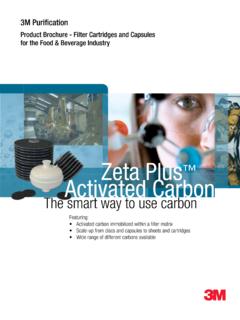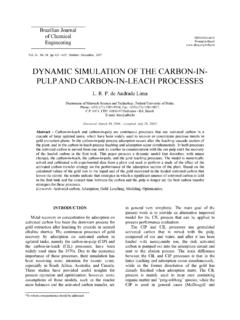Transcription of Removal of Dissolved Solids in Waste Water using …
1 Journal for Research| Volume 02| Issue 07 | September 2016. ISSN: 2395-7549. Removal of Dissolved Solids in Waste Water using activated carbon from Coconut Shell Geena G. Pradeep Krishna Priya Sukumaran UG Student UG Student Department of Civil Engineering Department of Civil Engineering M. A. College of Engineering M. A. College of Engineering Georgette George Febin Muhammad UG Student UG Student Department of Civil Engineering Department of Civil Engineering M. A. College of Engineering M. A. College of Engineering Nisha Mathew Assistant Professor Department of Chemistry M. A. College of Engineering Abstract Effective Removal of Dissolved Solids in drinking Water as well as Waste Water has gained considerable significance these days because of the high level of TDS. Adsorbents are popular and effective in the Removal of Dissolved Solids in Water . activated carbon is one of the most effective media for removing a wide range of contaminants from Waste Water .
2 activated carbon prepared from Waste materials is effective in removing the Dissolved Solids in Water . This paper present the effectiveness of activated carbon prepared from coconut shell in Waste Water purification especially for the Removal of Dissolved Solids . Amount of Dissolved Solids in Waste Water collected from the college premises was estimated before and after treatment with activated carbon . Waste Water was treated with activated carbon prepared from coconut shell for a period of 5 minutes, 30 minutes and 60. minutes. Treatment for 5 minutes was not enough for the effective Removal of Dissolved Solids . Amount of Dissolved Solids decreases with increase in time of treatment, and stirring for 20 to 30 minutes could bring it to a level well below the permitted value. Treatment for 60 minutes has reduced the TDS to a considerable extent. Keywords: activated carbon , Coconut Shell, Dissolved Solids , Pyrolysis, Waste Water _____.
3 I. INTRODUCTION. The amount of toxic soluble Solids in Waste Water has drastically increases because of the use several house hold and industrial chemicals. Goal to achieve the effective recycling of Waste Water in order to overcome the scarcity of Water has gained considerable interest these days. Purification of Waste Water is the process of removing undesirable chemicals, biological contaminants, Dissolved Solids and suspended Solids from contaminated Water . Different steps are adopted in the treatment of Waste Water but Dissolved Solids are not removed to a satisfactory level. Adsorbents gained attention from scientific community due to its effectiveness in different fields..Adsorbents plays a crucial role in treatment of domestic as well as Waste Water . Hence the generation of cheaper and economical adsorbents also gained significant attention these days.
4 activated carbon or charcoal is one of the adsorbent widely used in different areas. activated carbon is found to be effective for drinking Water purification, food and beverage processing, odor Removal etc. activated carbon is one of the most effective media for removing a wide range of contaminants from Waste Water as well. Hence the generation of activated carbon with high surface area for adsorption from cheap raw materials is a challenge for the scientific community. In this paper, generation of activated carbon from coconut shell and its effectiveness in Water purification especially for the Removal of Dissolved Solids has been discussed. II. PREPARATION OF activated carbon . Charcoal was prepared using two metal containers, one larger container and one smaller container. The larger container was 30cm high and 25cm diameter and the smaller container was 25cm high and 20cm diameter.
5 The smaller container was filled with firewood and the larger container was placed on the top of the smaller one. A cut was made on the top and bottom of the larger container so that a pipe can be inserted through it. The size of the cut at the bottom of the larger container was smaller than that of the pipe. Then the coconut shells were filled in the larger container after inserting the pipe. The container was closed tightly. The firewood was lighted at a very high temperature. The gases go out through the pipe while the coconut shell gets converted to carbon at high temperature. After 2-3 hours the carbon was taken out from the larger container. All rights reserved by 5. Removal of Dissolved Solids in Waste Water using activated carbon from Coconut Shell (J4R/ Volume 02 / Issue 07 / 002). The coconut shell charcoal was activated by reaction with steam at a temperature of 900 oC -1100oC under controlled atmosphere in a rotary kiln.
6 The reaction between steam and charcoal takes place at the internal surface area, creating more sites for adsorption. The temperature factor, in the process of activation was considered very important because below 900 oC the reaction becomes too slow and is very uneconomical and above 1100 oC the reaction becomes diffusion controlled and therefore takes place on the outer surface of the charcoal resulting in loss of charcoal. III. TREATMENT OF Waste Water WITH activated carbon . Waste Water collected from the college premises was subjected to analysis for total Dissolved salts (TDS) before and after treatment with activated carbon prepared from coconut shell. Waste Water was allowed to stir with activated carbon using a magnetic stirrer for various intervals such as 5 minutes, 30 minutes and 60 minutes. TDS was determined before and after treatment with activated carbon for various intervals using Systronics TDS meter.
7 Treatment of Waste Water using activated carbon was carried out at room temperature. After treating with activated carbon , it was filtered using Whatman filter paper and filtrate was used for the estimation of TDS. IV. RESULTS AND DISCUSSION. From the table given below it is clear that, the amount of Dissolved salts has considerably decreased by increasing the time of treatment with activated carbon . This clearly indicates that activated carbon prepared from coconut shell is highly efficient in treatment of Water especially in removing the Dissolved Solids . There are different methods available for the Removal of Dissolved salts but most of them are expensive methods and a common man cannot afford those methods. This method is an economically viable and suitable one for reasonably contaminated Water . The data obtained are summarized in the table given below.
8 Table 1. Results & Discussion Time of treatment in minutes TDS Permitted Value 0 750 mg/l 500 mg/l 5 555 mg/l 500 mg/l 30 257 mg/l 500 mg/l 60 50 mg/l 500 mg/l The data given in the above table can be graphically represented as below. From the graph it is clear that the amount of Dissolved Solids decreases with increase in the time of treatment. From the trend shown in the graph, we can come to a conclusion that stirring for a period of seventy minutes could completely remove the Dissolved Solids present in Waste Water . Fig. 2: Results It is also observed that stirring for a period of nearly 10 minutes can bring the TDS level to a level just below the permitted value. In order to make this a cost effective process, one could select time of stirring between 20 and 30 minutes for an effective Removal of Dissolved Solids in Waste Water . It is also expected that a considerable reduction in the TDS can be achieved quickly at higher temperatures.
9 But a room temperature process is always preferred over a higher temperature one due to energy concerns. This clearly indicates an effective reduction of TDS present in Waste Water by treating with activated carbon from coconut shell for a period of 20 to 30 minutes. The extent of Removal of Dissolved Solids from Waste Water is an indication of the very high surface area of the activated carbon prepared in this study. With increase in surface area, the number of sites for adsorption also increases. Now a days adsorption chemistry plays a crucial role in many areas especially in Water purification. Various adsorbents are known but the importance of activated carbon is still outstanding. We know the use of charcoal for removing impurities for a long time. But All rights reserved by 6. Removal of Dissolved Solids in Waste Water using activated carbon from Coconut Shell (J4R/ Volume 02 / Issue 07 / 002).
10 activated carbon with high surface area is proved to be a much effective for the Removal of impurities compared to charcoal. Different methods are available for the activation of carbon , viz. physical and chemical methods. Capacity for adsorption depends on the method of activation as well. activated carbon prepared from various sources exhibit different level of adsorption capacities. Agricultural Waste materials are now widely used as a source for the preparation of activated carbon . This is also considered as a viable solution for the effective utilization of Waste materials and conversions of these into value added products. This is considered as a significant method because of its relevance in protection of the environment. V. CONCLUSION. activated carbon prepared from coconut shell is found to highly effective in the reduction of TDS in Waste Water . The high surface area of activated carbon prepared in this study is responsible for the effective reduction in TDS.






